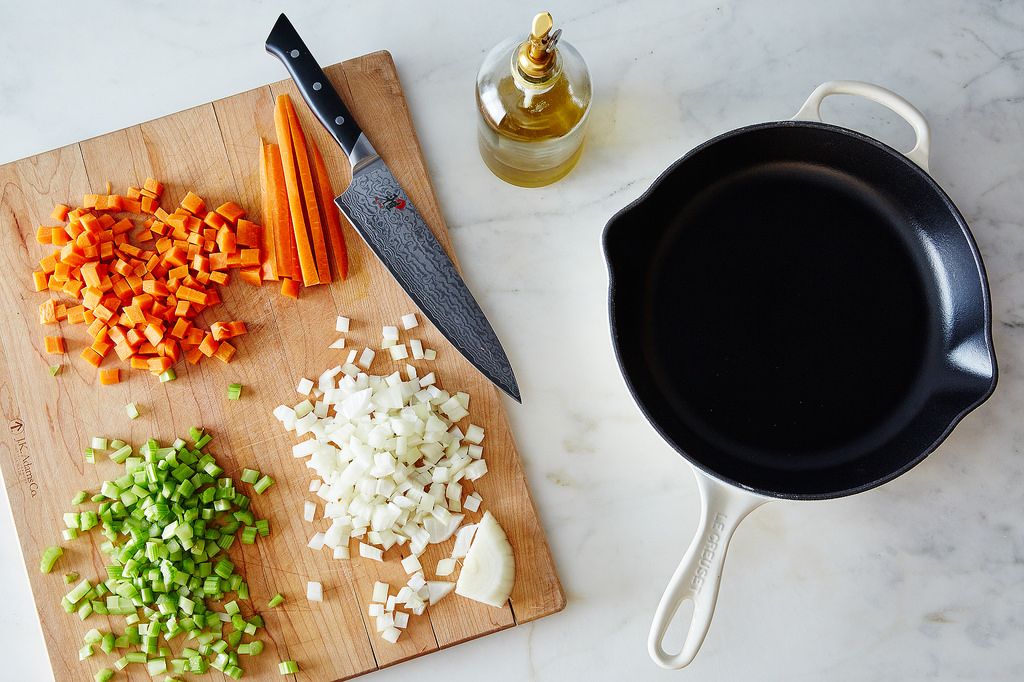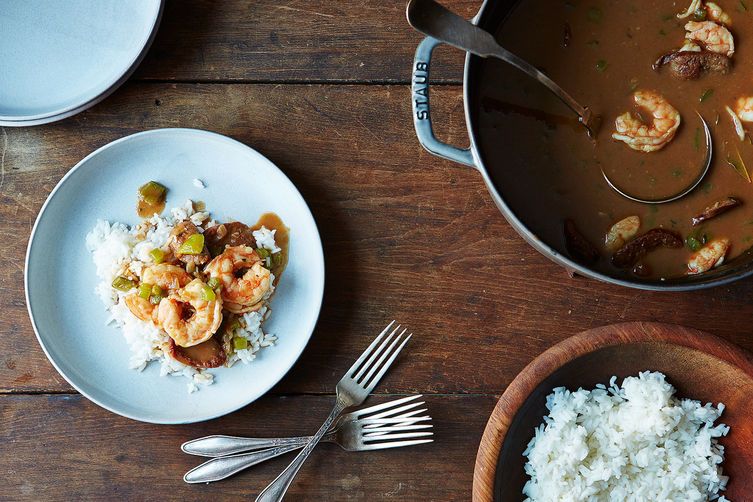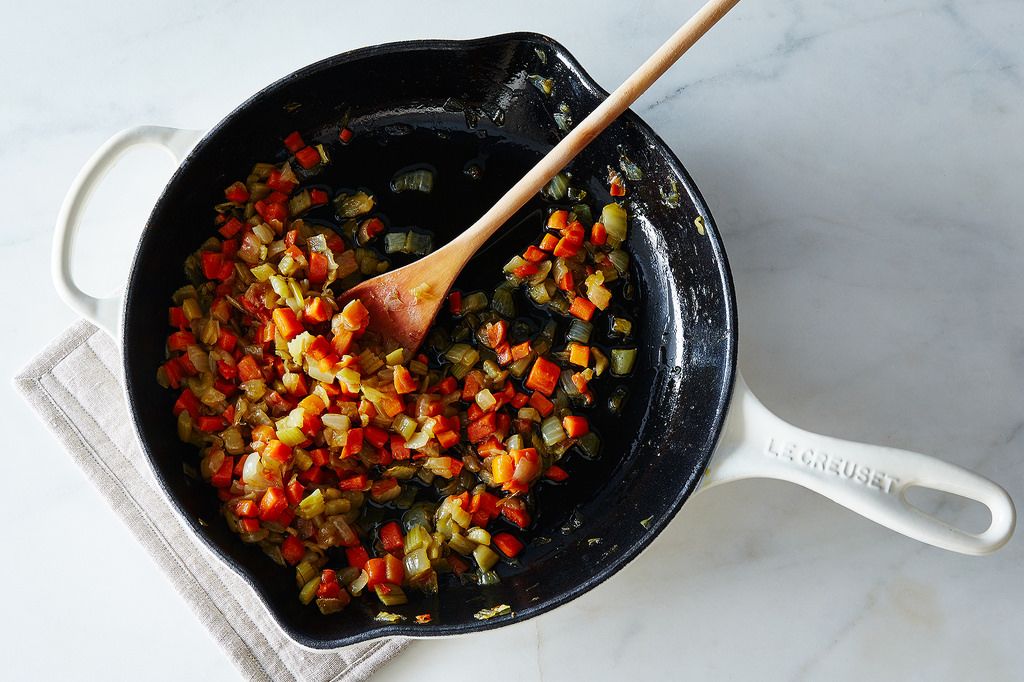
A New Way to Dinner, co-authored by Food52's founders Amanda Hesser and Merrill Stubbs, is an indispensable playbook for stress-free meal-planning (hint: cook foundational dishes on the weekend and mix and match ‘em through the week).
Order nowPopular on Food52
Continue After Advertisement
61 Comments
Brian W.
August 13, 2017
I was never taught about it but used to make pasta sauce following the advice of my Roman father-in-law. I slowly incorporated it into my soups, chicken and dumplings, stuffiness etc with subtle variations. Nice to sneak extra veggies into any dish.
Kathleen E.
February 5, 2017
I make up large amounts of this in the summer with all the CSA vegetables that I get. Once finished I freeze scoops of it in cupcake pans (smear the pan with olive oil first then fill and set in the freezer.) Once frozen pop them out, wrap each one in film or aluminum foil, and drop them in a freezer ziplock. I use gallon freezer ziplocks and then I always have this necessary first step ready to go - even on a quick dinner night.
Sharon
July 13, 2016
To: Petra Liverani. Hi Petra. I was unable to reply directly to your post because there is no "reply" button/link for any posts. Go figure! Anyway, a mirepoix refers to the basic flavoring agent of onions, carrots and celery. However, it does not specify how it should be prepared, while a soffritto is always sautéed.. It derives its rich flavor from the caramelization of the selected vegetables. A mirepoix, on the other hand, does not refer to any particular cooking method, but merely to that trio of aromatic vegatables. It is typically used as the building block for clear poaching liquids (ie. poached fish) and white (veal or chicken) soup stocks, for example. If you throw those same ingredients into a sauté pan and caramelize them, they become a soffritto. Of course, the secret of good cooking is to customize these basics to enhance each dish you're preparing. The only rule is that there are no rules, unless you want everything you cook to taste the same. Mexican, Italian, North African, American South, Cuban, Caribbean, etc., all have their own unique caramelized flavor bases for their cuisines.
Petra L.
April 11, 2017
Thanks, Sharon. Interesting. I just came across your answer randomly now. Perhaps I somehow missed it before.
rich M.
July 1, 2017
you're mixing italian cooking terms with French terms. soffritto is italian. mirepoix is french.
rich M.
July 1, 2017
i.e battuto is the mirepoix equivalent. when a battuto is fried or cooled, it becomes a soffritto.
Sharon
July 1, 2017
The origin of the word sofritto is Italian, but it's the same word and meaning in Spanish - to lightly fry. In fact, the first time I ever heard it was from Spanish-speaking Cuban cooks, ions ago. But, you know, Italy, Spain, Portugal - kissin' cousins! Lots of the same words and phrases floated back and forth throughout those countries.
Katherine
May 22, 2016
Thanks, Barb. Great idea. I have retired somewhat recently, and have renewed my love and study of food. So addictive -- cooking, shopping, eating, and researching. Off I go to my cookbooks. Have a lot of classics.
Barb
May 22, 2016
Katherine, carrots and onions seem to be a staple, the third can vary depending on country. Sometimes bell pepper (or something hotter). Asian has something else, is it onion, garlic and ginger? Read a few dozen recipes for the cuisine of choice and you'll find the pattern.
I read this article hoping for something more about long term than '3 days, in oil'. I was thinking of doing all the cleaning and chopping, and then freezing large quantities, either cooked or not, to use later. I think I'll just try both ways myself and see which is more successful.
I read this article hoping for something more about long term than '3 days, in oil'. I was thinking of doing all the cleaning and chopping, and then freezing large quantities, either cooked or not, to use later. I think I'll just try both ways myself and see which is more successful.
Katherine
May 17, 2016
Well, all I know is that celery is classic in at least two flavor bases. The classic in French cuisine (which is actually used pretty generally) is celery, carrots, and onion. I love Creole and New Orleans cuisine in general. A must flavor base is celery, onion, and green pepper. The area that I am just delving into is Spanish and Mexican foods, among others that are related. Again, my question is: is there a classic mix in these areas, plus or minus celery?
Edd T.
May 17, 2016
I still don't get celery.
I never use it in any of my flavor base.
Can anyone give a very good reason for it?
I never use it in any of my flavor base.
Can anyone give a very good reason for it?
Stef_art
May 17, 2016
celery brings a savory/earthy/mineral note to the onion & carrot mix, which could be otherwise too sweet
Sharon
May 17, 2016
You're right, celery is not always called for. It works really well in Italian dishes, especially in things like bolognese sauce. It's also good in white beans. Never seen it used in developing Mexican or North African flavors. My relatives way down in Louisiana nearly always add celery along with the onions and bell peppers for their basic sauté/caramelization, but it's not a given for me because it's not a note I want in everything. Some people don't seem to understand that there is no such thing as a "definitive" soffritto. In fact, most people don't even call it that! No one in my lineage ever called it that. It's simply the basic flavoring agent, customized to whatever you happen to be cooking at the moment. Add or omit whatever you want. The addition of carrots is pretty much a European thing from what I've seen in the world. Certainly not a part of everyone's culinary heritage. Sometimes you want carrots or celery, sometimes you don't. But you ALWAYS start with onions and garlic. BTW, some folks are confusing a mirepoix (French word) with a soffritto (Spanish word). Not the same. A soffritto is specifically sautéed to develop deep flavor through varying degrees of caramelization. Not the case with a mirepoix.
Katherine
May 16, 2016
This string is absolutely interesting to me, especially since flavor is one of my cooking bugaboos. I am curious about sofritos. All over the web there seem to be strong opinions about which is more authentic or best. Any thoughts as to what constitutes a really good sofrito?
Aina L.
May 16, 2016
I have only used it classically like in ragu ill have to try it out on other things now.
Jim W.
May 15, 2016
Soffrito, sofrito, mirepoix, battuta, suppengruen, the Cajun the holy trinity of onion, celery, and sweet peppers, the list goes on and on. I enjoyed your article.
Katherine
July 4, 2015
I'd like to know more about Tarka and how it's used. Can you recommend good sources?
Ron
July 3, 2015
For Indian cooking we have what we call Tarka. This is the base of most our Indian dishes. It's a mixture of onions, garlic, ginger and spices. Usually we make it fresh for each dish, but it can be made ahead of time and used as a base.
celia Y.
July 4, 2015
can you tell us the spices you are using -basic- ? I love Indian food but I don't know much about it. Yesterday I went to an Indian store and bought some of its vegetables (don't know the names) but I am going to try to make them. But dont' know what spices I should use. Thank you for any information.
MealFit T.
June 9, 2015
Good article! Simple. We sometimes get carried away with wanting what is new and cool. The thing is, good food is cool and this is good food. Thanks
Katherine
June 8, 2015
Catherine Lamb, I started cooking when I was 8 years old. I will be 69 in October. I went to culinary school for a year and worked in the field for a short while. I have lots of cook books and read numerous magazines. I have to say every time a turn a page I learn something new. My husband and I have sought out "food adventures" throughout our marriage 47 years). One of the many blessings of cooking is that it never gets boring.
Katherine
June 8, 2015
Heatherann, went to the link you provided. I really enjoyed it and will add some of the twists and turns to my established repetoire. Imagine the joy of learning at this old age. Also, love to impart my spaghetti sauce philosophy: There are as many recipes for spaghetti sauce as there are cooks. And when you consider the regions of Italy, as well as the permutations in both traditional and contemporary Italian cooking...well I rest my case. I imagine to some degree that applies to sofrito, mirepoix, etc. That's the wonderful, organic beauty of cooking -- you never, ever know it all!
Paisley D.
June 4, 2015
Yeah, that's mirepoix, not sofrito. Sofrito has tomatillos and recao.
celia Y.
July 4, 2015
Deptends what country you are. This sofrito is used and called in Spain and other LatinAmerican countries. En others the same thing is called differently. and the word 'mirepoix' is French, in spanish -some countries- we called different, and in English depends to whom you are talking. There'r different ways to call things (the same thing) even in the USA.
cristiana
June 1, 2015
Attention to color : it should not become golden , but remain transparent . Otherwise you may feel a burning smell.
Catherine L.
June 8, 2015
Good point! I found a few different rules about how golden the mixture should get, but general wisdom is that the vegetables should be relaxed and smell awesome, but not become golden.
Sharon
July 3, 2015
I beg to differ. That depends entirely upon what flavor base you're building. Golden color equals rich, golden flavor. As the saying goes, "there's flavor in the brown." For example, the haunting beauty of Indian cuisine is built upon the deep caramelization of onions & aromatics, and the toasting of spices. Knowing how to achieve and when to use these varying degrees of coloration is paramount to becoming an excellent cook.
Lygia B.
May 31, 2015
This is universal cooking. In Brazil/Portugal, we call it refogado, and it is the way of spicing up the basic black beans, as well as just about any other dish you can think of. I recently proposed an article as a food writing assignment entitled: "Sofrito, refogado, mirepoix, holy trinity -- sauce, dish or cooking method -- the universal way of sauteeing bulbs, vegetables, herbs and spices as a first step towards culinary nirvana."
Sharon
May 31, 2015
I can't believe that this is "news" to so many people! Practically EVERY good meal starts with this basic caramelized flavoring, and it varies depending upon the region and culture. In Louisiana, for example, it usually includes bell peppers, and not everyone uses carrots, being too sweet. No matter what, garlic is always in the mix. Can't imagine storing anything like this because it should be customized to whatever cuisine you're preparing. This is as natural and basic to any good cook as breathing. I learned this at my mother's knee.
heatheranne
May 31, 2015
I know it seems silly, but for those of us who didn't grow up learning how to cook, it really is news! I did realize that every dish seem to start with sauteing some combinations of carrot, onion, celery etc., but I didn't make the connection that cuisines all used a different and particular combination to build flavour.
Michael L.
June 1, 2015
I'll join in as a 'wow, wasn't aware of this' reader. And I'll also ask, with regard to the comment "You can store the soffritto in oil for up to three days in...", how much oil?
I wouldn't imagine it's submersion, but then again, this was 'news' to me. ;)
I wouldn't imagine it's submersion, but then again, this was 'news' to me. ;)
heatheranne
June 3, 2015
Yes, it's submersion (but just submerged). At least that's what I've been taught. I prefer freezing for long-term storage.




See what other Food52 readers are saying.